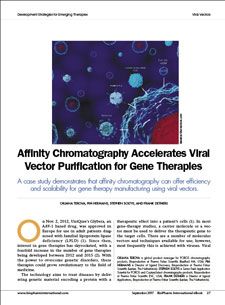Affinity Chromatography Accelerates Viral Vector Purification for Gene Therapies
A case study demonstrates that affinity chromatography can offer efficiency and scalability for gene therapy manufacturing using viral vectors.
On Nov. 2, 2012, UniQure’s Glybera, an AAV-1 based drug, was approved in Europe for use in adult patients diagnosed with familial lipoprotein lipase deficiency (LPLD). Since then, interest in gene therapies has skyrocketed, with a fourfold increase in the number of gene therapies being developed between 2012 and 2015. With the power to overcome genetic disorders, these therapies could prove revolutionary to the field of medicine.
The technology aims to treat diseases by delivering genetic material encoding a protein with a therapeutic effect into a patient’s cells. In most gene-therapy studies, a carrier molecule or a vector must be used to deliver the therapeutic gene to the target cells. There are a number of molecular vectors and techniques available for use; however, most frequently this is achieved with viruses.
Download the
BioPharm International’s 2017 Development Strategies for Emerging Therapies eBook.
Article Details
BioPharm International
eBook: Development Strategies for Emerging Therapies
Vol. 30
September 2017
Pages: 27–30
Citation
When referring to this article, please cite it as O. Terova et al., "Affinity Chromatography Accelerates Viral
Vector Purification for Gene Therapies," BioPharm International Development Strategies for Emerging Therapies eBook (September 2017).

Teva and Samsung Bioepis Launch Biosimilar Eculizumab in US Market
April 17th 2025Eculizumab-aagh (EPYSQLI) is now available in the US to treat patients living with difficult-to-treat rare diseases such as paroxysmal nocturnal hemoglobinuria, atypical hemolytic uremic syndrome, and generalized myasthenia gravis.
Teva and Samsung Bioepis Launch Biosimilar Eculizumab in US Market
April 17th 2025Eculizumab-aagh (EPYSQLI) is now available in the US to treat patients living with difficult-to-treat rare diseases such as paroxysmal nocturnal hemoglobinuria, atypical hemolytic uremic syndrome, and generalized myasthenia gravis.
2 Commerce Drive
Cranbury, NJ 08512
All rights reserved.
